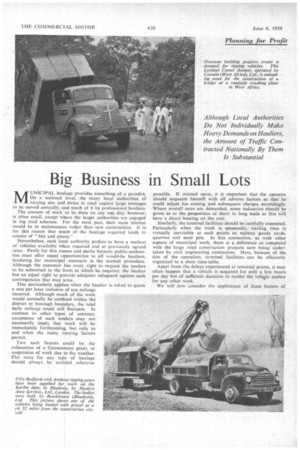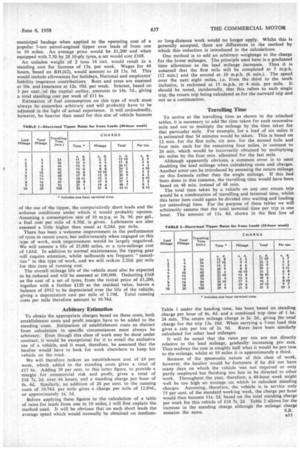Big Business in Small Lots
Page 92

Page 99

If you've noticed an error in this article please click here to report it so we can fix it.
UNICIPAL haulage provides something of a paradox. On a national level, the many local authorities of Varying size and status in total require large tonnages to be moved annually, and much of it by professional hauliers. The amount of work to be done on any one day, however, is often small, except where the larger authorities are engaged in big road schemes, For the most part, their main interest would he in maintenance rather than new construction. It is for this reason that much of the haulage required tends to consist of " bits and pieces."
Nevertheless, each local authority prefers to have a nucleus of vehicles available when required and at previously agreed rates. Partly for this reason and partly because public authorities must offer equal opportunities to all would-be hauliers. tendering for municipal contracts is the normal procedure. Although the customer has every right to request the tenders to be submitted in the form in which he requires, the haulier has an equal right to provide adequate safeguard against such contingencies that may arise.
This particularly applies when the haulier is asked to quote a rate per hour inclusive of any mileage incurred. Although much of the work would normally be confined within the district or -borough boundary, the total daily mileage could still fluctuate. In contrast to other types of contract, acceptance of such tenders may not necessarily imply that work will he immediately forthcoming, but only as and when the many varying factors permit.
Two such factors could be the exhaustion of a Government grant, or suspension of work due to the weather. Flat rates for any type of haulage should always be avoided wherever possible. If insisted upon, it is important that the operator should acquaint himself with all adverse factors so that he could adjust his costing and subsequent charges accordingly. Where overall rates are demanded, some indication should he given as to the proportion-of short to long leads as this will have a direct bearing on the cost.
Similarly, the terminal facilities should be carefully examined. Particularly when the work is spasmodic, waiting time is virtually inevitable at such points as railway goods yards, quarries and sand pits. In this connection, as with other aspects of municipal work, there is a difference as compared with the large road construction projects now being undertaken by civil engineering contractors. Here, because of the size of the operation, terminal facilities can be efficiently organized to a close time-table.
Apart from the delays experienced at terminal points, it may often happen that a vehicle is acquired for only a few hours per day but of sufficient duration to render the vehigle useless for any other work, We will now consider the application of these factors of
municipal haulage when applied to the operating cost of a popular 5-ton petrol-engined tipper over leads of from one to 10 miles: . An average price would be £1,200 and when equipped with 7.50 by 20 10-ply tyres, a set would cost £168.
An unladen weight of 2 tons 14 cwt. would result in a standing cost for licences of 13s. per week. Wages for 44 hours, based on RH.(62), would amount to £8 15s. 9d. This would include allowances for holidays, National and employers' liability insurance contributions.. Rent and rates are assessed at 10s. and insurance at 12s. 10d. per week. Interest, based on 3 per cent, of the capital outlay, amounts to 14s. 5d., giving a total standing cost per week of £11 6s.
Estimation of fuel consumption on this type of work must always be somewhat arbitrary and will probably have to be adjusted in the light of actual experience. It will undoubtedly, however, be heavier than usual for this size of vehicle because
of the use of the tipper, the comparatively short leads and the arduous conditions under which it would probably operate. Assuming a consumption rate of 10 m.p.g. at 3s. 9d, per gal., a fuel cost per mile of 4.50d. is given. Lubricants are also assessed a little higher than usual at 0.24d. per Mile.
There has been a welcome improvement in the performance of tyres in recent years, but unfortunately when engaged on this type of work, such improvement would be largely negatived. We will assume a life of 25,000 miles, or a tyre-mileage cost of 1.61d. In addition to normal maintenance, the tipping gear will require attention, whilst tailboards are frequent " casualties " in this type of work, and we will reckon 2.20d. per mile for this item of running cost.
The overall mileage life of the vehicle must also be expected to be reduced and will be assessed at 100,000. Deducting £168 as the cost of a set of tyres, from the initial price of £1,200, together with a further £120 as the residual value, leaves a balance of £912 to be depreciated over the life of the vehicle, giving a depreciation cost per mile of 2.19d. Total running costs per mile therefore amount to 10.74d.
Arbitrary Estimation To obtain the appropriate charges based on these costs, both establishment costs and profit margin have to be added to the standing costs. Estimation of establishment costs as distinct from calculation in specific circumstances must always be arbitrary. Even though this class of work may be don6 under contract, it would be exceptional for it to entail the exclusive use of a vehicle, and it must, therefore, be assumed that the haulier would have to look for work elsewhere to keep his vehicle on the road.
We will therefore reckon an establishment cost of £4 per week, which added to the standing costs gives a total of £15 6s. Adding 20 per cent, to this latter figure, to provide a margin for commercial risk and profit, gives a total of £18 7s. 2d. over 44 hours, and a standing charge per hour of 8s. 4d. Similarly, an addition of 20 per cent, to the running costs of 10.74d. per mile gives a charge per mile of 12.89d., or approximately ls. ld.
Before applying these figures to the calculation of a table of rates for leads from one to 10 miles, I will first explain the method used. It will be obvious that on such short leads the average speed which would normally be obtained on medium or long-distance work would no longer apply. Whilst this is generally accepted, there are differences in the method by which this reduction is introduced in the calculations.
One method is to add an arbitrary weightage to the charge for the lower mileages. The principle used here is a graduated time allowance as the lead mileage increases. Thus it is assumed that the first mile will be completed at 5 m.p.h. (12 mm.) and the second at -10 m.p.h. (6 min.). The speed over the next eight miles, i.e. from the third to the tenth inclusive, is reckoned at 15 m.p.h. or 4 min. per mile. It should be noted, incidentally, that this refers to each single trip, the return trip being calculated as for the outward trip and not as a continuation.
Travelling Time To arrive at the travelling time as shown in the attached tables, it is necessary to add the time taken for each successive mile and not to multiply the mileage by the time taken for that particular mile. For example, for a lead of six miles it is estimated that 34 minutes would be taken. This is based on 12 mm. for the first mile, six min. for the second inile and four min, each for the remaining four miles, in contrast to 24 mm. which would be incorrectly obtained by multiplying six miles by the four rnM. allocated for the last mile.
Although apparently obvious, a common error is to omit doubling the lead mileage when calculating costs and charges. Another error can be introduced by assessing the return mileage on this formula rather than the single mileage. If this had been done in this instance, the travelling time would have been based on 48 min. instead of 68 mm.
The total time taken by a vehicle On any one return trip would be a combination of travelling and terminal time, whilst this latter item could again be divided into waiting and loading (or unloading) time. For the purpose of these tables we will arbitrarily assume that the total terminal time per trip is one hour. The amount of lls. 8d. shown in the first line of
Table 1 under the heading time, has been based on standing charge per hour of 8s. 4d. and a combined trip time of 1 hr. 24 min. The return mileage charge is 2s. 2d., giving he total charge for the trip 13s. 10d. When carrying a 5-ton load this gives a rate per ton of 2s. 9d. Rates have been similarly calculated for other lead mileages.
It will be noted that the rates per ton are not directly relative to the lead mileage, gradually increasing pro rata. Thus midway the rate is roughly half what it would be pro 'rata to the mileage, whilst at 10 miles it is approximately a third.
Because of the spasmodic nature of this class of work, however, the haulier would be fortunate if he did not have many days on which the vehicle was not required or only partly employed but finishing too late to be directed to other 'work. Throughout the year, therefore, a. 44-hour week might well be too high an average on which to calculate standing charges. Assuming, therefore, the vehicle is in service only 75 per cent, of the standard working week, the charge per hour would then become lls. 2d. based on the total standing charge per week for this vehicle of £18 is. 24. Table 2 allows for the increase in the standing charge although the mileage charge remains the same, S.B.








































































































































